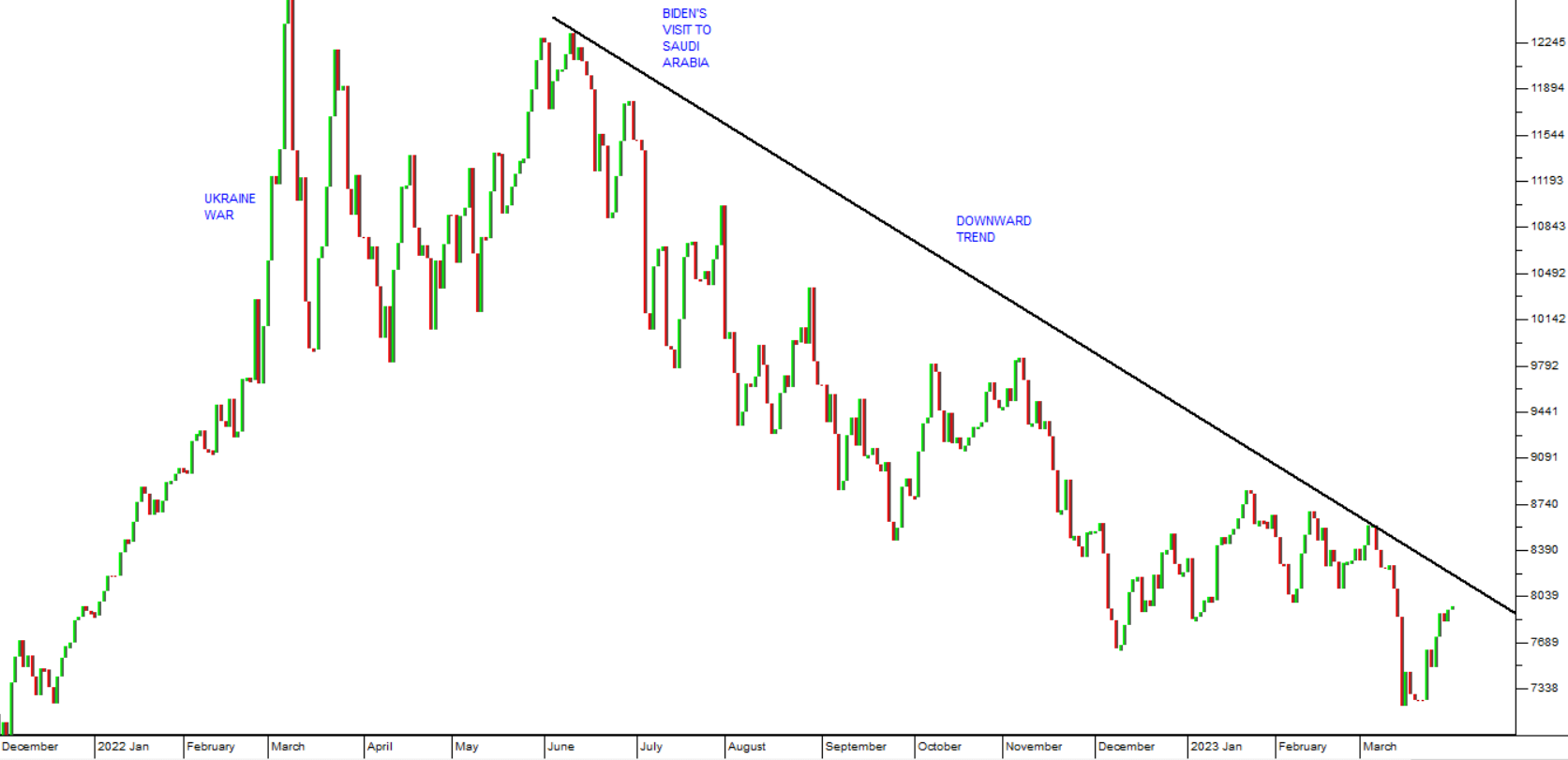Oil and US Inflation
17 April 2023 By PDSNETThe US core personal consumption expenditure (PCE) price index is the Federal Reserve Bank’s (The Fed) preferred gauge to measure inflation in that country because it excludes both food and energy prices. The PCE has remained at more-or-less the same level for the past 5 months from November 2022 to February 2023. In November 2022 it was 4,8%, 4,6% in December, 4,7% in January 2023, 4,6% in February and 4,7% in March.
In our opinion, investors have been focused on the consumer price index (CPI) and have not been giving the core PCE the attention which it deserves. This explains the unusual and protracted bullishness in the S&P500 index in recent weeks. The CPI, of course, has been heavily impacted by the price of oil.
With that in mind, consider the chart of the dollar price of North Sea Brent oil since December 2021:

Here you can see that the oil price has been falling steadily since President Biden visited Saudi Arabia in June last year. But in the last few days it has spiked up – breaking above its long-term downward trendline. Could this be the start of a new upward trend?
The decline in the price of oil has had an immediate and substantial impact on the consumer price index (CPI). It is the primary factor in bringing the CPI down from 9,1% in June 2022 to 5,2% in March 2023 - but the underlying core inflation (the PCE) has remained stubbornly high. For the past 4 months, investors have been discounting the falling CPI and have not paid much attention to the fact that core inflation has not come down significantly.
Core inflation still reflects a US economy that is running hot. It has generated more than 340 000 new jobs a month on average this year. The rate of job creation is declining, but it remains very high. The unemployment rate also shows a very tight labour market At 3,5%, it is at or close to what economists consider to be full employment. And there are about 1,7 jobs on offer in America for every job seeker.
The jump in the oil price over the past month since OPEC announced its intention to restrict supply may well indicate that the season of lower oil prices is at or close to its end. A rising oil price will certainly push US inflation higher.
The picture which emerges from these facts is that the Fed will probably have to remain hawkish for the rest of this year. It would be well to consider the old Wall Street aphorism “...the Fed keeps on tightening until something breaks”. The collapse of Silicon Valley Bank (SVB) is not big enough to be “something breaking”. Interest rates will have to go higher and stay at higher levels for some time to reach the Fed’s stated goal of bringing inflation down to 2%. There has been much talk about a “pivot” point, where the Fed changes direction and begins to reduce interest rates, but that surely cannot happen this year or even early next year.
The S&P500 is once again testing its long-established resistance level at 4170. We will be surprised if it penetrates this level significantly. In fact, we are expecting it to fall back now as investors increasingly digest the reality that the US economy has to go into recession before the Fed can pivot. Furthermore, it is well to remember that, historically, Wall Street has usually continued downwards for some time after the point when interest rates began to fall.
Since the stock markets of the world, including the JSE, follow Wall Street it is important to watch developments there.
DISCLAIMER
All information and data contained within the PDSnet Articles is for informational purposes only. PDSnet makes no representations as to the accuracy, completeness, suitability, or validity, of any information, and shall not be liable for any errors, omissions, or any losses, injuries, or damages arising from its display or use. Information in the PDSnet Articles are based on the author’s opinion and experience and should not be considered professional financial investment advice. The ideas and strategies should never be used without first assessing your own personal and financial situation, or without consulting a financial professional. Thoughts and opinions will also change from time to time as more information is accumulated. PDSnet reserves the right to delete any comment or opinion for any reason.
Share this article:









